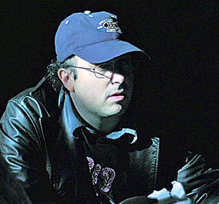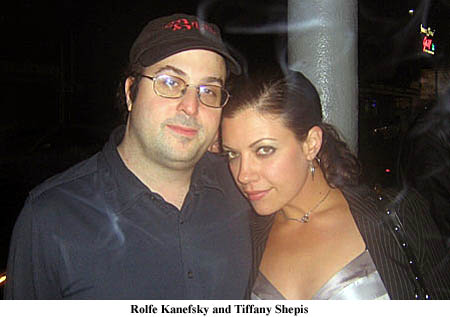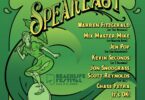
His newest venture into the horror world, “Nightmare Man,” written, directed and produced by Kanefsky, will be released to select theatres in all the major cities across the U.S on November 9th. Getting there, however, has been a long process filled with ups and downs. Though “Nightmare Man” received incredible feedback and won several awards in various film festivals (including Best Director awards at the 2006 Horror, Sci-Fi, Fantasy and the Supernatural Film Festival in Las Vegas and the 2006 IFFYNTX Festival in Texas), the current over-saturation of horror films proved to be a detriment for Kanefsky, as he had little luck finding a distributor for the horror flick.
The quality of the film spoke for itself, however, when Rolfe submitted “Nightmare Man” to the After Dark Horrorfest, an annual celebration of the horror genre in which 8 horror, supernatural and thriller films are chosen to be released for 10 days in 350 theatres nationwide.
Being chosen as one of the “8 Films to Die For” in the Horrorfest, After Dark Films and Lions Gate will release “Nightmare Man” to theatres nationwide on November 9th, with a DVD release date to follow in early 2008.
Rolfe took time from his busy schedule to talk to LA’s the Place about “Nightmare Man.”
Excerpts from the interview:
Karleigh Behbahani/LATP: You’ve done several horror films in the past. Do you normally find that the market is over saturated with horror films and it’s hard to get someone to buy it?
Rolfe Kanefsky: Well it goes up and down. I mean, horrors always- horror in general, has always been a label that studios and Hollywood have always, you know, thump their noses at. It’s always been considered one small step above pornography because it makes tons of money but it doesn’t win awards, unless special effects, but it doesn’t get the acclaim or attention. So they tend to, you know, they like to take in the billions of dollars that are generated by these movies, “Friday the 13th” and all these films but they feel bad about it because in their mind they’re going for the lowest common denominator. Although, you know, I mean, there’s Hitchcock and Spielberg and “Jaws” and you know, “The Exorcist,” I mean, you know, horror films have always been the first films to break a hundred million dollars and to actually make records because it taps into that roller coaster of you know, people like to be scared. I mean, “The Blair Witch Project”- I mean, it never goes away even though they love to say, if a horror film bombs, “oh horror’s dead, horror’s dead.”
LATP: It is interesting though, because like you mentioned “Friday the 13th,” I mean, the really classic horror films really stick. Audiences love them and yet there aren’t as many of them as compared other genres but it’s not necessarily because the audience isn’t interested; it’s just that no one wants to take the risk and buy it?
RK: Yeah, they just want, like I said in the 40s, you know, Universal was saved by the monster movies. “Dracula,” “The Werewolves,” “Frankenstein,” that’s what saved Universal from going under. I mean, the films have always been the big generator and there are just as many great horror films as there are comedies and dramas and everything else, so…Yes, there’s a lot of bad ones as there are in any genre because once something’s successful, everyone jumps on the bandwagon and that’s exactly what happened at the end of the 70s and 80s with “Halloween.” “Halloween” became so popular, everyone started making these low budget slasher films and then…and then in the late 80s when video hit there was such a big straight-to-video thing that it sorta flooded the market, and that’s when people said there’s too many to choose from and that’s when they started going away. So there was a lull from the end of 80s to beginning of 90s and then “Scream” technically brought the whole thing back in ’96 when it reinvented the whole self-reflective horror, you know, with a sense of humor, with a wink to the audience. Um, although there is a history with that that I have as well, I don’t know if you know that whole story.
LATP: Yeah. “There’s Nothing Out There.” I was actually going to ask you about that.
RK: Yeah. (Laughs) Exactly.
LATP: Was that your first film or the first one you got noticed for?
RK: That was my first professional film. I mean, I had found a video camera when I was 13 years old and I started making home movies on video and made like, 2, you know shot on video feature films when I was in high school before I went to college, and then did a couple super 8 short films. And then there’s nothing out there where the first one where, I was ready, I’d been – my parents had been in the film business. My father was a film editor, my mother used to be a singer and dancer on Broadway so they were always very supportive of what I wanted to do.
But I was always very much into commercial, fun films. But actually, I loved comedy, Abbot and Costello movies were a big influence and Abbot and Costello meets Frankenstein – combining comedy and horror – you know, still is probably the best example of working; it was a big influence there too. So when I wrote “There’s Nothing Out There,” I was in high school at the time and I thought it would fun to make fun of all the clichés and conventions in horror films – and this was back in 1986 when wrote the first draft, so I thought that I got into horror films because I realized most filmmakers – and I knew at 14 that I wanted to be a filmmaker – had started with horror movies because it was a great training ground without relying on big budgets or big name actors. And you know, Spielberg, Coppola, Oliver Stone, they all started with horror films.
So I said if I’m gonna do a horror films, I wanna really know the genre inside and out so I started renting out every horror film on video. And I realized upon renting all these films, I’d never seen so many clichés and conventions. Like the cat that jumps out of nowhere and people that drop a knife or stand in front of an open window or go into the basement by themselves where audiences would just be able to yell at the screen, “Don’t do that, you’re an idiot. You deserve to die.”
So I thought, I said, you know I’ve never seen – in a horror movie at the time – a character that was the audience. That actually would say and do all those things to the other characters around them. So I said that would be kind of fun.
You have someone who’s the audience in the movie. And, that was the character of “Mike” in “There’s Nothing Out There,” who happened to be a good friend of mine from high school. A high school friend of mine, Craig Peck’s first movie. So we did the film and the reaction was exactly that – that people loved the film, they thought it was so much fun. And because it did poke fun – it wasn’t making fun of horror films, it was making fun of lazy conventions that I think is what hurts horror movies. The fact that people just rely on the same old “jump scare,” it gets tiresome after a while. Think of something new; be more creative. And that’s what I was making fun of with that. And, it caught on and people really seemed to enjoy it.
However, studios once again and, agents, were the people that didn’t understand it. They were like, well, it’s too funny to be scary, it’s too scary to be funny, you know I don’t really see how this would and yet we were playing film festivals in Europe and all over the place and getting good reviews in the trade papers; The New York Times, The L.A. Times. Everyone was embracing the film because they liked the fact that it was fun; it had a sense of humor to it. So I was like, if someone comes along and does a film like this, with enough budget and somebody in the movie with a name, it’s gonna make a fortune. And um, we started filming in ’92, it was officially released and then 4 years later was when “Scream” came out and sure enough, it proved correct.
LATP: What year was that? ’89?
RK: We shot the film in ’89, uh, the film was released in ’92 theatrically. Small theatrical release, and then in ’96 is when “Scream” came out, so that was 6 years between the two.
LATP: I’ve read people comparing it to “Scream” and said this was sort of the pre-cursor because you were the first one to—
RK: Yeah, it was funny cause I- you know, cause when “Scream” came out everyone was saying, “Did you see the trailor?” And I like “Scream,” and I thought “Scream” is more of a scary horror film. There’s nothing out there really tongue-in-cheek, making fun, it doesn’t go as far as “Airplane” or “Scary Movie” but it is making fun of that type; it crosses the line a little bit into Mel Brooks’ territory, and we’re making fun of monster movies versus slashers, which “Scream” focuses on. But I like “Scream” a lot and I was very happy that it brought back the horror genre at the time and of course, because of that, everyone started saying, “You should remake ‘There’s Nothing Out There’ or “You should do a rip off of ‘Scream.’” And I was like, “Well I don’t’ wanna rip off a film that sort of, you know, came from me anyway, so, um, I tried to come up with another film. “Hazing,” which was my follow up to that after many years out of the genre.
LATP: “The Hazing?” What was that about?
RK: It was a horror comedy about a group of kids pledging a sorority/fraternity house who have to spend the night in a haunted house for their task. And um, the gimmick in that one was you meet all the kids, and you’ve got the blonde bimbo cheerleader, you’ve got the computer geek, you’ve got the jock. All your clichés, but once the horror kicks in and becomes real, the kids drop the façade and become real people and you realize that the blonde bimbo’s not that dumb, she just acts that way cause guys like that sort of thing. So I decided, why don’t we try to do “Breakfast Club” as a horror film? But you think you’ve seen all the clichés and then suddenly the kids aren’t—they’re acting like real people so you don’t know who should live and die and that would make it another twist on the genre. So that was my gimmick on that thing. And the film, you know, got a very good reaction; it didn’t get a theatrical release, but it went straight to video, but it did wonderful on video at Blockbuster and Hollywood and it did great units wise and it’s on cable all the time, and again, people really embraced that film and got it and a lot of people said they were surprised we didn’t get a theatrical shot. And we had Brad Dorff in the movie from “Lord of the Rings,” so we had some really strong actors in the film and Tiffany Shepis. That was the first time I’d officially worked with Tiffany and um, it started out really well. So with that second film after “There’s Nothing Out There,” then I started getting more into- and then horror was so popular, there was more money in the genre, so it was easier to find financing to do my next couple of genre films, which also were in the uh, horror/comedy realm.
LATP: So was horror something you’ve always wanted to do or did you just – you wanted to be a filmmaker and you thought that was a good way to…
RK: Well, comedy is what I fell in love with. But I did have a real attraction to, obviously, Abbot and Costello meets the Monster movies; “Mummy,” “Dr. Jekyll and Mr. Hyde,” you know, “Frankenstein.” So I always found that trend you know, where you’re balancing the elements to be a challenging one as a filmmaker, but if you walk that line, it’s great.
LATP: I was going to ask you about “Nightmare Man,” so you can tell everyone about that film. Would you say that mixes different genres as well?
RK: “Nightmare Man,” well “Nightmare Man” was my attempt to do more of a straighter horror film, although it is funny in places. Um, my twist has always been since I watch…I mean, I watch everything and the character of Mike in “There’s Nothing Out There” is very similar to me and I’d watch every horror film there is out there and I like movies in general. So it’s always trying to take a genre or take a convention and twist it just enough so it makes it fresh and original. Because I mean, everything’s been done before, somehow. So it’s like, well, what’s the point of doing it again if you’ve seen it a hundred times unless you can come up with a new angle on it. So with uh, with “There’s Nothing Out There,” it was making fun of all the horror conventions and spoofing the cat scares and things like that to make it sort of fun. In “Hazing,” it was making fun of the characters. I’m like, let’s play around with the characters and make them into more interesting people. And in “Nightmare Man,” it’s really playing around with the plot. It’s that it seems like a very generic, standard storyline and then everything sort of twists and turns on itself. So what you think is going one place and leads the audience into that area, suddenly I pull the rug from under you and you’re into another whole thing. So I think the element of surprise, um, has caught people off guard on the film. That there…they think they know exactly where it’s going and they don’t. And so that’s what I decided to play around with was structure, you know, in that film. So it’s always finding new thing. Now, the plot of “Nightmare Man,” which I guess I’ll just tell you a little bit for it. Just tell you some of the plot…
LATP: Yeah. Yeah…
RK: Okay, again, simple story. Woman with her husband, having trouble in their marriage, in their sex life. She buys a…she gets a fertility mask, which is supposed to help them, in the mail. It becomes- it turns into this weird mask that she doesn’t think she quite ordered; this demonic African thing. That night she’s attacked by an entity or the being or somebody who’s in wearing the “Nightmare Man” mask. So she thinks she was attacked by this creatural person named the “Nightmare Man.” Her doctors and husband believe she’s a paranoid schizophrenic, so they are on their way…her husband’s taking her to be committed at an institution when the car breaks down in the road, in the middle of nowhere in the woods. He goes to get gas; she waits in the car and gets attacked again by the Nightmare Man, or is it in her mind? Escaping into the woods, she finds a house where two young couples are vacationing for the summer- for a weekend- and um, gets involved there and then all of a sudden everything starts going from bad to worse. People start getting killed; you’re not quite sure what’s real, what’s in the mind. You know, who’s behind it all. So…you know, again, it’s a very simple- is it a slasher film or is it a psychological thriller or is it a supernatural something or other. So the film plays on all that to keep you guessing until the end where it’s gonna go. You know there’s nervous comedy in the movie where, you know, once they’re in that situation there’s a lot of jokes or just, you know nervous tension. But that’s funny as well, so there is humor.
LATP: How do you approach directing a horror film versus a straight up comedy? How do you help the actors prepare for the gruesome death scenes and things like that?
RK: How do you prepare the actors for it?
LATP: Yeah. Do you have a different approach for directing scenes like that as opposed to just regular, straight comedic scenes or anything?
RK: Well, I mean, in all films, comedy or horror, it has to be real for the actors. I mean, even with comedy, the best comedy comes out of reality. Where, you know, it might be very funny, but you know, you have to believe your situation that you’re in. You know if you’re being stalked by a killer, or you know, you have the really feel that tension, you have to be scared. You know, the screams have to be real. If it’s all fake, it takes the audience out of the reality you’re trying to build. You’re always trying to create an environment in a movie that the audience can accept even if it’s a zany comedy or whatever, you know, I can see that happening. “It’s Mad Mad Mad Mad World,” one of the best ones, it’s based on greed. You know, if I knew where a million dollars was buried, you know, I’d try to go get it. You know, people can relate to people on the screen, even if they’re doing crazy things because people do do crazy things. And in horror films, it’s the same thing in terms of, you know, if I’m being, if somebody’s outside my bedroom window that I think is a killer, you have to believe that the danger is there and that you could get killed. So you have to be scared. When you’re actually doing a horror film, it’s more fun because you know, it is a make believe thing and when you’re dealing with blood and effects, you know, people tend to have a really good time. When you watch it on the screen, it can be horrific. But when you’re doing it with all the technical stuff, usually people just have a lot of fun doing horror films; getting covered in blood and, you know, getting hacked up (laughs).
LATP: It sounds fun!
RK: Tiffany I know loves…that’s the thing with Tiffany, she loves doing horror films. And she loves the blood and the guts and all that kind of stuff. She just has a ball with it.
LATP: You guys have worked together a few times, you and Tiffany. Right?
RK: Yeah, we’ve worked together 7 times now.
LATP: “Nightmare Man” is being released on November 9th – for one week- in theatres and you also have another film being released the same day, correct?
RK: It’s supposed to be, um, there’s been back and forth. A company called First Look has the rights to “Blonde and Blonder.” This is a film I wrote 10 years ago, actually. Pamela Anderson and Denise Richards- and they made the film last year. We showed it at the Cannes Film Festival this last May. So I flew out there to see it. And the film is, yes, it’s supposed to come out November 9th, um, there’s potential it might be pushed back a little bit. I know what the street date on DVD is. It’ll be early next year on February 5th. But they’re going back and forth because Pamela Anderson has so much personal issues in the news that they’re trying to focus on one thing at a time. So the film may not come out November 9th. It may be delayed a little bit. But uh, it will be coming out soon and then coming out on DVD. It should do very well. It’s a female “Dumb and Dumber” and um, my take was to try to do a sort of younger, sexier “I Love Lucy.” I always go back to Abbot and Costello, Lucille Ball-
LATP: Well, they’re classic formulas that work, so why not?
RK: Yeah, exactly, they’re…but that’s the thing with Hollywood. They have very little attention spans or knowledge of history of films. They know 10 years but that’s about it, but I tend to go back to the 40s and the classic stuff that I grew up on and that I love still and was funny and wittier and more intelligent than some of the more recent. You know, the “Dumb and Dumber” things are just fine, but you know, if you can go back to some of the traditional classic comedy, I think that still plays and works beautifully for people. And um, Pamela Anderson’s company produced the movie with a company in Canada. It was done up in Canada. And it was also a film, that uh, although we shouldn’t go too much into it, that was officially directed by a very good filmmaker named Bob Clarke, who had done the original “Porky’s” and the original “Black Christmas” and “A Christmas Story,” the classic “Christmas Story.” I don’t know if you’ve heard, earlier this year, he and his son were killed in that fatal automobile accident- that tragedy on the PCH.
LATP: Yes…
RK: And um, he’s not getting director credit on the film because of Canadian content rules so…the film is dedicated to him, but uh, he did not get the credit even though he did do the movie. After a 40 year career, it’s kind of a- the politics of Hollywood; money overrides artistic integrity. So it’s a sad story with that but uh, great guy, I met the man, he’s a very nice guy and he has a very influential career of his own. So that was, that’s “Blonde and Blonder.”
LATP: Thank you for taking the time to talk to me today. Good luck on your films. Do you have any upcoming projects you’re working on right now?
RK: Yeah, the next film- well, there’s two that are coming up the closest. The one with Tiffany and Esther um, which we actually haven’t really announced to anyone yet. If this does come through, we might shoot in January. It’s a thing called “The Devil’s Pies,” which is kind of a sorority comedy/horror/splatter comedy. “The Devil’s Pies,” which, it might be Tiffany’s directing debut and we’ll help her produce it and I wrote the script. And a slasher film I wrote, a horror thing called, “Caller Unknown,” which is pretty scary. It’s like “When a Stranger Calls” meets “Friday the 13th.” Kids in the woods and a killer terrorizing people through their cell phone, and uh, that’s supposed to go into production maybe in March or April of next year, um, with a producer named Mark Freedman, who just did “Resurrecting the Champ” with Samuel L. Jackson. So it’s like a $2 million horror film that could be a really good franchise and I’m attached to direct that film. So again, one that’s sort of comedy, one that’s sort of horror. I like going back and forth between the two of them. And recently I just wrote a script that just won a big screenwriting award at L.A. Street Fest. It was one of two winners of 400 script submitted and there were two winning screenplays.
LATP: Congratulations!
RK: Thanks. Yeah, it’s called “Horror World,” which is like a big budget action-horror film, um, kind of like Night of the Museum of horror, with the ultimate scream part. It’s a great love letter to the genre and covers every single aspect of horror films; it’s all rolled into one. Kind of a horrific version of “Fantasy Island.” So that could be a lot of fun. And that’s one that I would love to do but would happily sell because it’s probably a $50 million budget, which they might not let me do at this stage but it’d be a great film for people.
LATP: Good luck. I’m really looking forward to seeing “Nightmare Man.”
To see trailers for “Nightmare Man” or find showtimes and theatres near you, visit www.horrorfestonline.com. Trailers can also be seen on www.youtube.com and www.rolfekenefsky.com.









